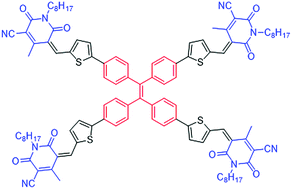当前位置:
X-MOL 学术
›
Mater. Chem. Front.
›
论文详情
Our official English website, www.x-mol.net, welcomes your feedback! (Note: you will need to create a separate account there.)
Cyanopyridone flanked the tetraphenylethylene to generate an efficient, three-dimensional small molecule non-fullerene electron acceptor
Materials Chemistry Frontiers ( IF 7 ) Pub Date : 2017-09-06 00:00:00 , DOI: 10.1039/c7qm00355b Anushri Rananaware 1, 2, 3 , Akhil Gupta 3, 4, 5 , Gajanan Kadam 6, 7, 8 , Duong Duc La 1, 2, 3 , Ante Bilic 3, 9, 10 , Wanchun Xiang 11, 12, 13 , Richard A. Evans 3, 14, 15 , Sheshanath V. Bhosale 1, 2, 3
Materials Chemistry Frontiers ( IF 7 ) Pub Date : 2017-09-06 00:00:00 , DOI: 10.1039/c7qm00355b Anushri Rananaware 1, 2, 3 , Akhil Gupta 3, 4, 5 , Gajanan Kadam 6, 7, 8 , Duong Duc La 1, 2, 3 , Ante Bilic 3, 9, 10 , Wanchun Xiang 11, 12, 13 , Richard A. Evans 3, 14, 15 , Sheshanath V. Bhosale 1, 2, 3
Affiliation

|
Herein we report the design, synthesis and characterization of a novel material, (5Z,5′Z,5′′Z,5′′′E)-5,5′,5′′,5′′′-(((ethene-1,1,2,2-tetrayltetrakis(benzene-4,1-diyl))tetrakis(thiophene-5,2-diyl))tetrakis(methanylylidene))tetrakis(4-methyl-1-octyl-2,6-dioxo-1,2,5,6-tetrahydropyridine-3-carbonitrile) (TPE-CP4), which was generated using a combination of tetraphenylethylene and cyanopyridone functionalities. The tetraphenylethylene unit was terminally functionalized with cyanopyridone in order to generate a three-dimensional molecular architecture. The new material TPE-CP4 was produced via a Knoevenagel condensation reaction and was found to be highly soluble in a variety of common organic solvents, such as chloroform and o-dichlorobenzene. TPE-CP4 exhibited promising optoelectronic properties and energy levels complementing those of the conventional donor polymers poly(3-hexylthiophene) [P3HT] and Poly({4,8-bis[(2-ethylhexyl)oxy]benzo[1,2-b:4,5-b′]dithiophene-2,6-diyl}{3-fluoro-2-[(2-ethylhexyl)carbonyl]thieno[3,4-b]thiophenediyl}) [PTB7]. Due to its optoelectronic properties, solubility and good film forming capability, TPE-CP4 was incorporated as an n-type semiconducting component along with the commercially available P3HT and PTB7 as the p-type semiconductors in BHJ photovoltaic devices. TPE-CP4 performed very well with both of the donor polymers and afforded 6.02% and 6.72% power conversion efficiencies with P3HT and PTB7, respectively. Not only is TPE-CP4 the first reported example combining tetraphenylethylene and cyanopyridone structural units, but the device performance indicates that it is an efficient non-fullerene acceptor.
中文翻译:

氰基吡啶酮位于四苯基乙烯的侧面,可生成高效的三维小分子非富勒烯电子受体
本文我们报告的设计,合成和新材料的表征,(5 Ž,5' Ž,5'' Ž,5''' ë)-5,5-',5'',5''' - (( (乙烯-1,1,2,2-四基四(苯-4,1-二基))四(噻吩-5,2-二基)四(亚甲基)四(4-甲基-1-辛基-2,使用四苯基乙烯和氰基吡啶酮官能团的组合生成的6-二氧-1,2,5,6-四氢吡啶-3-甲腈(TPE-CP4)。为了产生三维分子结构,将四苯基乙烯单元用氰基吡啶酮末端官能化。新材料TPE-CP4是通过以下方式生产的进行Knoevenagel缩合反应,发现它可高度溶于各种常见的有机溶剂,例如氯仿和邻二氯苯。TPE-CP4展现出有希望的光电性能和能级,与传统的施主聚合物聚(3-己基噻吩)[P3HT]和聚({4,8-双[(2-乙基己基)氧基]苯并[1,2- b ] :4,5 - b ']二噻吩-2,6-二基} {3-氟-2-[(2-乙基己基)羰基]噻吩并[3,4- b ]噻吩二基})[PTB7]。由于其光电特性,溶解性和良好的成膜能力,TPE-CP4在BHJ光伏器件中,作为有机物的P3HT和PTB7与P3HT和PTB7一起作为n型半导体组分掺入。TPE-CP4在两种供体聚合物下均表现出色,并且P3HT和PTB7分别提供6.02%和6.72%的功率转换效率。TPE-CP4不仅是第一个报道的结合四苯基乙烯和氰基吡啶酮结构单元的实例,而且器件性能表明它是一种有效的非富勒烯受体。
更新日期:2017-09-14
中文翻译:

氰基吡啶酮位于四苯基乙烯的侧面,可生成高效的三维小分子非富勒烯电子受体
本文我们报告的设计,合成和新材料的表征,(5 Ž,5' Ž,5'' Ž,5''' ë)-5,5-',5'',5''' - (( (乙烯-1,1,2,2-四基四(苯-4,1-二基))四(噻吩-5,2-二基)四(亚甲基)四(4-甲基-1-辛基-2,使用四苯基乙烯和氰基吡啶酮官能团的组合生成的6-二氧-1,2,5,6-四氢吡啶-3-甲腈(TPE-CP4)。为了产生三维分子结构,将四苯基乙烯单元用氰基吡啶酮末端官能化。新材料TPE-CP4是通过以下方式生产的进行Knoevenagel缩合反应,发现它可高度溶于各种常见的有机溶剂,例如氯仿和邻二氯苯。TPE-CP4展现出有希望的光电性能和能级,与传统的施主聚合物聚(3-己基噻吩)[P3HT]和聚({4,8-双[(2-乙基己基)氧基]苯并[1,2- b ] :4,5 - b ']二噻吩-2,6-二基} {3-氟-2-[(2-乙基己基)羰基]噻吩并[3,4- b ]噻吩二基})[PTB7]。由于其光电特性,溶解性和良好的成膜能力,TPE-CP4在BHJ光伏器件中,作为有机物的P3HT和PTB7与P3HT和PTB7一起作为n型半导体组分掺入。TPE-CP4在两种供体聚合物下均表现出色,并且P3HT和PTB7分别提供6.02%和6.72%的功率转换效率。TPE-CP4不仅是第一个报道的结合四苯基乙烯和氰基吡啶酮结构单元的实例,而且器件性能表明它是一种有效的非富勒烯受体。



























 京公网安备 11010802027423号
京公网安备 11010802027423号